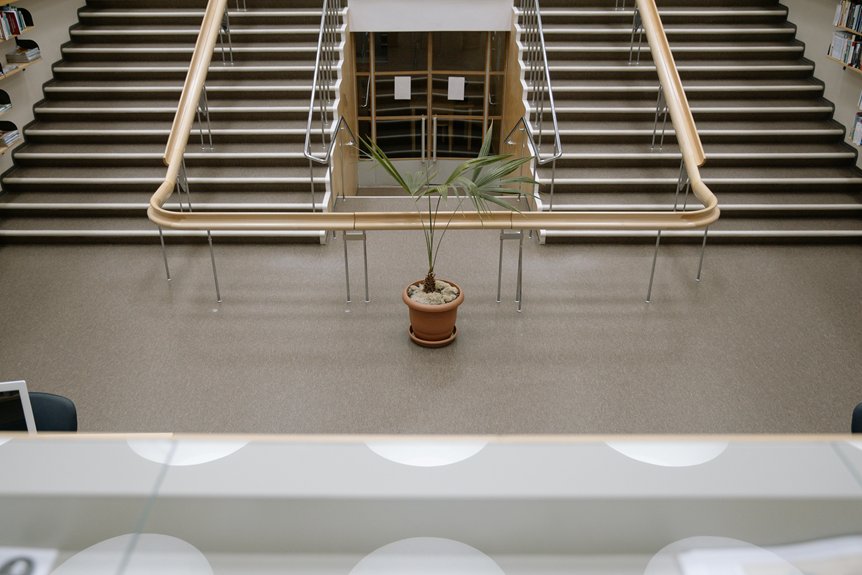If you’ve noticed dampness or mold in your basement, it’s time to take action. Waterproofing your basement walls isn’t just a task; it’s a necessity for maintaining a dry and safe environment. By following these seven essential steps, you can effectively tackle moisture issues and protect your home. But first, let’s assess the condition of your basement walls and identify any underlying problems that need to be addressed.
Key Takeaways
- Assess the basement walls for cracks, moisture, and material type to determine necessary waterproofing methods.
- Clean the walls thoroughly to remove dust, dirt, and mold using a stiff brush and bleach solution.
- Repair any identified cracks with appropriate materials such as caulk, epoxy, or hydraulic cement based on severity.
- Apply a suitable waterproofing sealant evenly across the walls, ensuring complete coverage and avoiding pooling.
- Consider installing a drainage system, like an interior French drain or sump pump, to manage water flow effectively.
Assess the Condition of Your Basement Walls
Before diving into waterproofing your basement, it’s essential to assess the condition of your basement walls.
Start by checking for any visible cracks or damage in the wall materials. Look for signs of moisture sources, such as water stains or damp spots. These indicators can help you identify potential problem areas.
Pay attention to the type of materials used in your walls; concrete and masonry are more resilient than wood. If you find significant issues, consider consulting a professional before proceeding.
Understanding your walls’ condition will guide you in selecting the right waterproofing methods for effective results.
Clean the Walls Thoroughly
To guarantee effective waterproofing, start by cleaning your basement walls thoroughly. Remove dust, dirt, and any debris using a stiff brush and vacuum.
Start your waterproofing project right by thoroughly cleaning your basement walls to ensure a successful outcome.
For mold prevention, mix a solution of water and bleach, applying it to areas with visible mold. Scrub these spots and rinse well to make certain the surface is free from contaminants.
If your walls are painted, consider stripping old paint to enhance surface preparation. This step is essential for proper adhesion of waterproofing products.
Finally, let the walls dry completely before proceeding with the next steps. A clean surface will help guarantee a successful waterproofing project.
Repair Any Cracks or Damage
Once you’ve cleaned the walls, it’s crucial to address any cracks or damage that could compromise your waterproofing efforts. Start by performing crack identification; look for visible gaps or fissures. Next, conduct a damage assessment to determine the severity. Here’s a quick guide to help you:
| Crack Type | Repair Method |
|---|---|
| Hairline Cracks | Caulk or Sealant |
| Small Cracks | Epoxy Injection |
| Large Cracks | Hydraulic Cement |
| Structural Damage | Consult a Professional |
Apply Waterproofing Sealant
Now that you’ve repaired any cracks, it’s time to apply waterproofing sealant to protect your basement.
First, you need to choose the right sealant for your specific needs, then make sure you’re using proper application techniques for the best results.
Don’t overlook the importance of allowing adequate curing time to maximize the sealant’s effectiveness.
Choose the Right Sealant
Choosing the right sealant is crucial for effective waterproofing of your basement walls.
Start by considering the sealant types available, like liquid rubber, epoxy, or acrylic. Liquid rubber offers flexibility, while epoxy provides a strong bond for more severe moisture issues. Acrylic is easy to apply and great for minor dampness.
Next, think about application methods; some sealants require brushes, while others can be sprayed on. Make certain to read the manufacturer’s instructions for ideal results.
Proper Application Techniques
To guarantee your waterproofing sealant is applied effectively, start by preparing the surface of your basement walls. Clean the walls thoroughly, removing any dirt, dust, or old paint.
Once the surface is prepped, choose a suitable application technique—either a brush, roller, or sprayer, depending on your sealant type. Apply the sealant evenly, ensuring complete coverage and avoiding pooling.
Work in sections to maintain wet edges, which helps with adhesion. Finally, pay attention to corners and joints, applying extra sealant where needed for maximum protection.
With proper surface preparation and application techniques, your basement will be well on its way to becoming waterproof.
Curing Time Importance
Although you may be enthusiastic to finish your basement waterproofing project, understanding the importance of curing time is essential for achieving a long-lasting seal.
Curing methods can greatly affect how well your waterproofing sealant performs. Make certain to follow the manufacturer’s instructions for ideal conditions, like temperature and humidity, to guarantee proper curing.
Rushing this step can lead to poor adhesion and eventual failure of the seal. Allow enough time for the sealant to cure fully, typically 24 to 72 hours, depending on the product.
Patience here will save you from future headaches and costly repairs.
Install a Drainage System
To effectively waterproof your basement, installing a drainage system is essential.
First, you’ll need to choose the right type of drainage, such as a French drain or a sump pump, based on your specific needs.
Then, guarantee proper grading around your home to direct water away from the foundation and prevent potential flooding.
Choose Drainage Type
When it comes to waterproofing your basement, selecting the right drainage system is essential for preventing water damage. You have several drainage options, each with unique drainage benefits. Here’s a quick overview to help you decide:
| Drainage Type | Benefits |
|---|---|
| Interior French Drain | Effective for indoor water flow |
| Exterior French Drain | Prevents water from reaching walls |
| Sump Pump | Removes water accumulation |
| Grated Drains | Directs water away from foundation |
| Surface Drainage | Handles surface runoff effectively |
Choose wisely to guarantee your basement stays dry and protected!
Implement Proper Grading
Implementing proper grading around your home is essential for effective water management and basement waterproofing. By directing water away from your foundation, you reduce the risk of moisture seeping into your basement.
Here are some grading techniques to take into account:
- Verify the ground slopes away from your home (at least 6 inches over 10 feet)
- Examine soil composition; clay holds water, while sand drains well
- Install a French drain if necessary
- Create swales or ditches to divert water
- Regularly maintain landscaping to prevent erosion
Use a Dehumidifier
A dehumidifier can be a game-changer for maintaining a dry basement environment. It effectively reduces moisture levels, preventing mold and mildew growth. Understanding the dehumidifier benefits helps you make informed choices for humidity control.
| Benefit | Description | Impact |
|---|---|---|
| Mold Prevention | Reduces moisture, inhibiting mold growth | Healthier air quality |
| Odor Elimination | Removes damp odors caused by excess moisture | Fresher basement smell |
| Structural Integrity | Prevents water damage to walls and foundation | Prolongs lifespan of home |
| Comfort | Creates a more comfortable living space | Enhanced overall comfort |
| Energy Efficiency | Helps HVAC systems work more effectively | Lowers energy bills |
Maintain Regular Inspections and Repairs
Maintaining regular inspections and repairs of your basement walls is essential for preventing long-term water damage.
Regular inspections and repairs of your basement walls are crucial to prevent costly long-term water damage.
You should conduct inspections at least every six months. During each inspection, focus on a thorough damage assessment to catch issues early.
- Check for cracks in the walls
- Look for signs of mold or mildew
- Inspect for water stains or discoloration
- Assess gutter and downspout drainage
- Confirm your waterproofing measures are intact
Conclusion
By following these essential steps, you’ll effectively waterproof your basement walls and protect your home from moisture damage. Start with a thorough assessment and cleaning, then make necessary repairs and apply a quality sealant. Don’t forget to install a drainage system to manage water flow. Using a dehumidifier can further enhance your efforts, and regular inspections will help keep everything in check. With these strategies, you can enjoy a dry, healthy basement for years to come.

